1 byte is equal to 8 bits (bit). In the binary number system, each 0 or 1 is a bit (bit), and a bit is the smallest unit of data storage; every 8 bits (bit, abbreviated as b) constitute a byte (Byte), so "1 byte ( Byte) = 8 bits”. In most computer systems, a byte is an 8-bit unit of data. Most computers use a byte to represent a character, number, or other character.

The operating environment of this tutorial: Windows 7 system, Dell G3 computer.
1 byte is 8 bits (bit), that is: 1byte = 8bit.
Byte (Byte) is a unit of measurement used by computer information technology to measure storage capacity. It also represents data types and language characters in some computer programming languages.
bit (bit), a computer term, is a unit of information and is transliterated from the English BIT. It is also a bit in a binary number, a measurement unit of information, and the smallest unit of information.
In the binary number system, each 0 or 1 is a bit, and a bit is the smallest unit of data storage. Among them, 8bit is called a byte (Byte) . The number of CPU bits in a computer refers to the maximum number of bits that the CPU can process at one time. For example, the CPU of a 32-bit computer can handle up to 32 bits of data at a time.

Data storage is in "byte" (Byte) as the unit, and data transmission is mostly in "bit" (bit, also known as "bit").A bit represents a 0 or 1 (i.e. binary), and every 8 bits (bit, abbreviated as b) constitute a byte (Byte, abbreviated as B) , which is the smallest level of information unit.
In most computer systems, a byte is an 8-bit long data unit. Most computers use a byte to represent a character, number, or other character. A byte can also represent a series of binary bits. In some computer systems, 4 bytes represent a word, which is the unit of data that the computer can efficiently process when executing instructions. Some language descriptions require 2 bytes to represent a character, which is called a double-byte character set. Some processors are capable of handling double-byte or single-byte instructions.
Unit conversion
Information storage is a measure of the amount of programs and data stored in memory. Its main unit of measurement is bytes, with 1 byte (Byte) equal to 8 bits (b) binary. Bit (Binary Digits): stores a binary number, that is, 0 or 1, which is the smallest storage unit. 8 binary digits are a byte unit. An English letter (regardless of case) occupies one byte of space, and a Chinese character occupies two bytes of space. English punctuation occupies one byte, and Chinese punctuation occupies two bytes
1 byte (Byte) = 8 bits (bit)
1KB(Kilobyte, kilobyte)=1024B
1MB(Megabyte, megabyte)=1024KB
1GB(Gigabyte, Jizi Trillionbyte, gigabyte)=1024MB
1TB(Trillionbyte, terabyte)=1024GB
1PB(Petabyte, Exabyte, petabyte) = 1024TB
- ##1EB(Exabyte, exabyte) = 1024PB
- 1ZB(Zettabyte, ten trillion bytes, zettabytes) = 1024EB
- 1YB(Yotabyte, one hundred trillion bytes, yaobytes) = 1024ZB
- 1BB(Brontobyte, billions of billions of bytes)=1024YB
Extended knowledge: words and word length
- Word (Word)In a computer, a string of numbers that are processed or calculated as a whole is called a computer word, or word for short. Words are usually divided into bytes (each byte is usually 8 bits). In memory, each cell typically stores one word. Therefore each word is addressable. The length of a word is expressed in bits.
- Word lengthThe number of bits contained in each word of a computer is called the word length. The calculated word length refers to the number of binary digits it can process at one time. . Generally, the word length of large computers is 32-64 bits, that of small computers is 12-32 bits, and that of microcomputers is 4-16 bits. Word length is an important factor in measuring computer performance.
FAQ column!
The above is the detailed content of 1 byte equals how many bits. For more information, please follow other related articles on the PHP Chinese website!
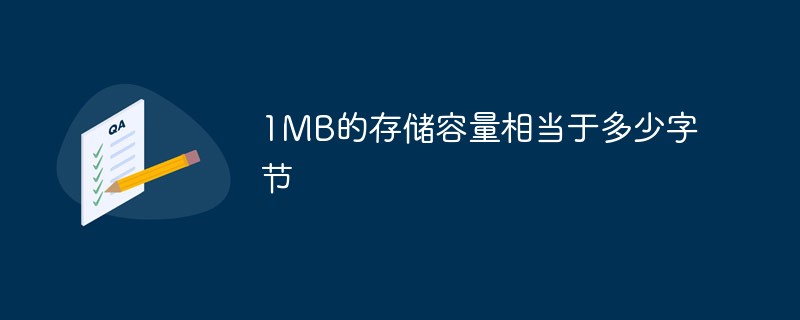 1MB的存储容量相当于多少字节Mar 03, 2023 pm 05:42 PM
1MB的存储容量相当于多少字节Mar 03, 2023 pm 05:42 PM1MB的存储容量相当于2的20次方个字节,即1048576个字节。MB是计算机中的一种储存单位,读作“兆”;因为1MB等于1024KB,而1KB等于1024B(字节),因此1MB等于1048576(1024 *1024)个字节。
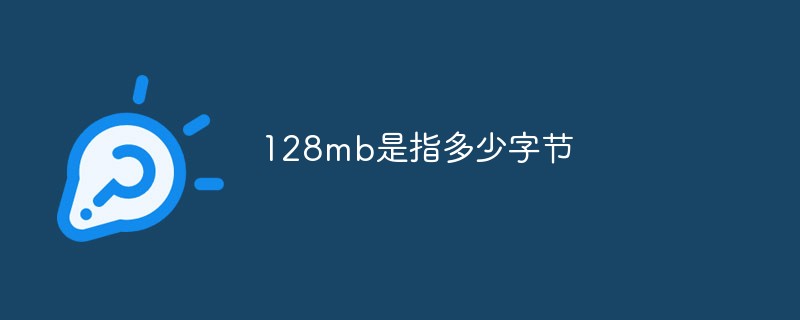 128mb是指多少字节Nov 29, 2022 am 10:35 AM
128mb是指多少字节Nov 29, 2022 am 10:35 AM128mb是指134217728字节;字节换算公式是“1MB=1024KB=1048576B=8388608bit”,其表示可以保存1048576个英文字母、524288个汉字;流量单位换算公式是1GB=1024MB,1MB=1024KB,1KB=1024B。
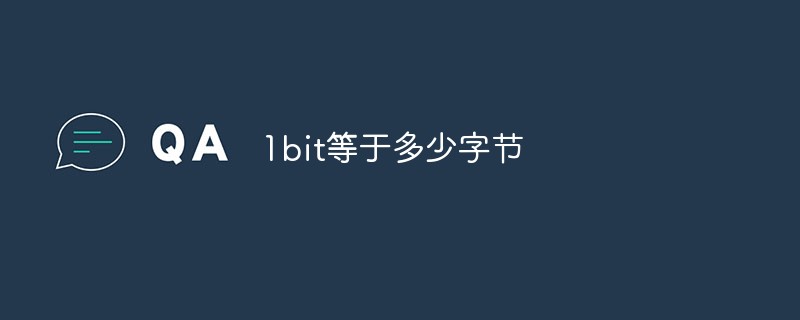 1bit等于多少字节Mar 09, 2023 pm 03:11 PM
1bit等于多少字节Mar 09, 2023 pm 03:11 PM1bit等于八分之一个字节。二进制数系统中,每个0或1就是一个位(bit),位是数据存储的最小单位;每8个位(bit,简写为b)组成一个字节(Byte),因此“1字节(Byte)=8位(bit)”。在多数的计算机系统中,一个字节是一个8位(bit)长的数据单位,大多数的计算机用一个字节表示一个字符、数字或其他字符。
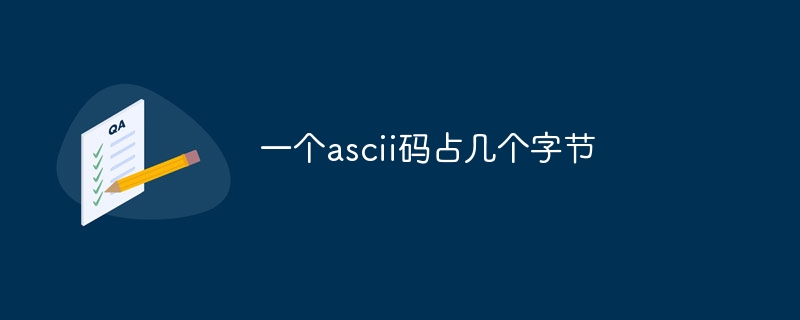 一个ascii码占几个字节Sep 07, 2023 pm 04:03 PM
一个ascii码占几个字节Sep 07, 2023 pm 04:03 PM一个ascii码占一个字节,ascii码是一种用于表示字符的编码标准,它使用7位二进制数来表示128个不同的字符,包括字母、数字、标点符号和特殊字符等。一个字节是计算机存储单位的基本单元,它由8个二进制位组成,每个二进制位可以是0或1,一个字节可以表示256个不同的数值,因此可以表示ascii码中的所有字符。
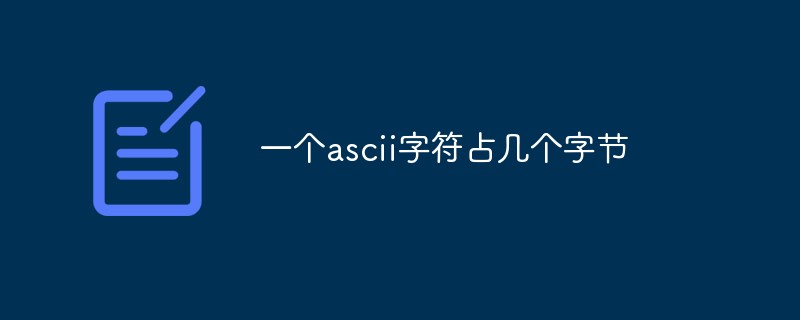 一个ascii字符占几个字节Mar 09, 2023 pm 03:49 PM
一个ascii字符占几个字节Mar 09, 2023 pm 03:49 PM一个ascii字符占1个字节。ASCII码字符在计算机中采用7位或8位二进制编码表示,并保存在一个字节中,即一个ASCII码占用一个字节。ASCII码可分为标准ASCII码和扩展ASCII码,其中标准ASCII码也叫基础ASCII码,使用7位二进制数(剩下的1位二进制为0)来表示所有的大写和小写字母,数字0到9、标点符号,以及在美式英语中使用的特殊控制字符。
 utf8编码汉字占多少字节Feb 21, 2023 am 11:40 AM
utf8编码汉字占多少字节Feb 21, 2023 am 11:40 AMutf8编码汉字占3个字节。在UTF-8编码中,一个中文等于三个字节,一个中文标点占三个字节;而在Unicode编码中,一个中文(含繁体)等于两个字节。UTF-8使用1~4字节为每个字符编码,一个US-ASCIl字符只需1字节编码,带有变音符号的拉丁文、希腊文、西里尔字母、亚美尼亚语、希伯来文、阿拉伯文、叙利亚文等字母则需要2字节编码。
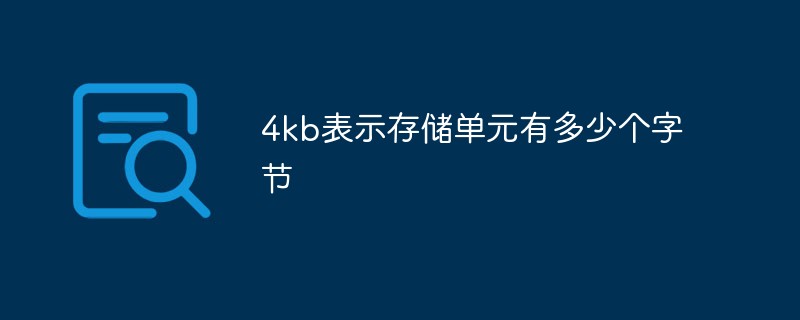 4kb表示存储单元有多少个字节Feb 28, 2023 pm 12:12 PM
4kb表示存储单元有多少个字节Feb 28, 2023 pm 12:12 PM4KB表示存储单元为4096个字节。KB指的是千字节,是计算机数据存贮器存储单位字节的多倍形式,一个千字节是基于2的幂次的,即一个千字节(1KB)等于1024个字节(B);因此“4KB=4*1024B=4096B”,即4KB表示4096个字节。
 PHP中int类型转换为字节的方法详解Mar 06, 2024 pm 06:18 PM
PHP中int类型转换为字节的方法详解Mar 06, 2024 pm 06:18 PMPHP中int类型转换为字节的方法详解在PHP中,我们经常需要将整数类型(int)转换为字节(Byte)类型,比如在处理网络数据传输、文件处理或者加密算法等场景中。本文将详细介绍如何将int类型转换为字节类型,以及提供具体的代码示例。1.int类型与字节的关系在计算机领域,基本数据类型int表示整数,而字节(Byte)是计算机存储单位,通常是8位二进制数据

Hot AI Tools

Undresser.AI Undress
AI-powered app for creating realistic nude photos

AI Clothes Remover
Online AI tool for removing clothes from photos.

Undress AI Tool
Undress images for free

Clothoff.io
AI clothes remover

AI Hentai Generator
Generate AI Hentai for free.

Hot Article

Hot Tools

SAP NetWeaver Server Adapter for Eclipse
Integrate Eclipse with SAP NetWeaver application server.

Dreamweaver Mac version
Visual web development tools

ZendStudio 13.5.1 Mac
Powerful PHP integrated development environment

Atom editor mac version download
The most popular open source editor

SublimeText3 Linux new version
SublimeText3 Linux latest version






